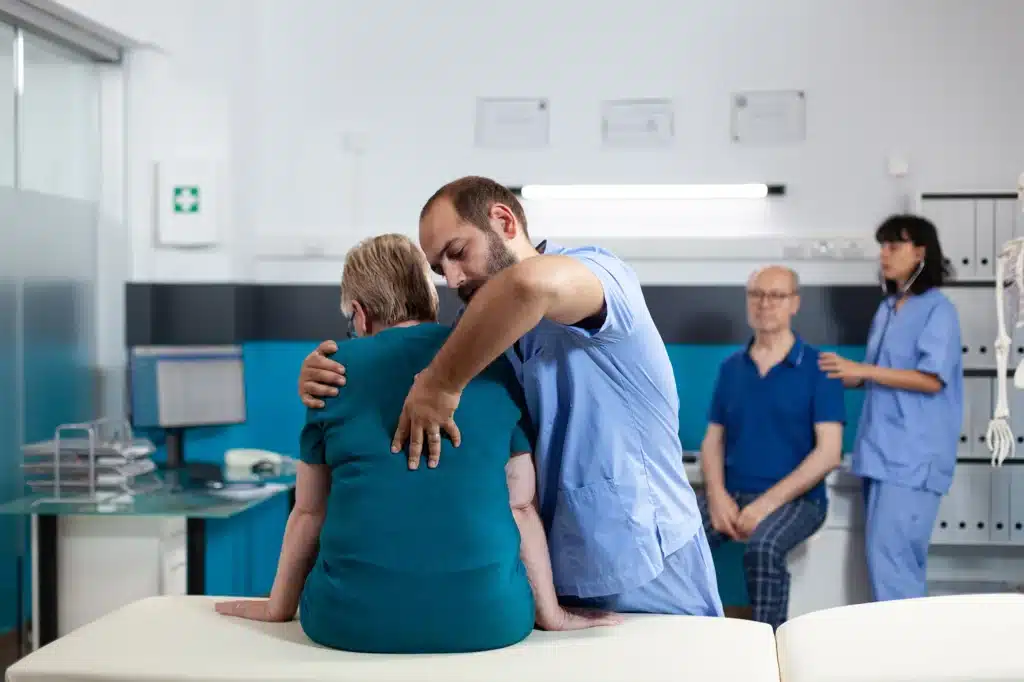
Table of Contents
ToggleWhen you hear the words Spinal Fusion, you might imagine something out of a science fiction novel. But in reality, it’s a surgery that has been giving people with back problems a new lease on life, right here on Long Island.
Whether you’re a sports enthusiast sidelined by pain or someone who’s day-to-day life is hindered by back issues, understanding Spinal Fusion might be the first step towards reclaiming your life. So, let’s dive into what Spinal Fusion is, why it might be needed, and what you can expect from it.
Imagine the spine as a stack of bony rings (vertebrae), with cushions (discs) in between each for flexibility and support. Now, if one or more of these rings start causing trouble—like pain due to movement—Spinal Fusion steps in as a solution.
This surgery permanently connects two or more vertebrae in your spine, eliminating motion between them and providing much-needed relief. It’s like if two gears were causing a machine to malfunction, and welding them together fixed the problem. That’s Spinal Fusion in a nutshell.

Not everyone with back pain will need Spinal Fusion. It’s usually considered when other treatments haven’t worked.
So, who exactly might need this surgery? People with conditions like severe arthritis causing spine instability, scoliosis (where the spine curves abnormally), or a herniated disc might be candidates.
It’s all about stabilizing the spine and alleviating pain that’s been limiting someone’s quality of life.
Undergoing Spinal Fusion can be a game-changer. For starters, it aims to alleviate chronic pain, allowing many to resume activities they thought were a thing of the past.
It’s about getting back to gardening without wincing, playing with your kids without pausing, or simply sitting comfortably at your desk job. Besides pain relief, Spinal Fusion also aims to correct spinal deformities and improve overall spinal stability.
It’s like pressing the reset button on your spine’s functionality.
While Spinal Fusion has its benefits, it’s crucial to weigh them against the potential risks. These can include infection, blood clots, and nerve damage, though such complications are relatively rare with modern surgical techniques.
Think of it as preparing for a big exam—the outcome is usually good, but it’s important to study and understand all possible outcomes.

After the surgical lights dim and the echoes of the operating room fade, the journey of recovery begins—a path marked not by swift strides but by measured, deliberate steps. Spinal Fusion recovery is a testament to the resilience of the human body and spirit, a period where patience becomes a virtue and progress, though gradual, sings a song of hope.
In the initial days following surgery, the hospital room serves as the first checkpoint, where pain management and healing command full attention. The melody of recovery plays differently for each individual, with some notes of discomfort but many chords of progress.
Pain, a temporary companion on this journey, gradually recedes as strength and mobility tiptoe back into the spotlight.
Physical therapy emerges as a beacon of recovery, a guide that leads patients through the exercises and stretches that knit strength back into muscles and flexibility back into movements. Imagine it as learning to dance again, where each session adds a beat to the rhythm of recovery.
The goal is not just to mend but to fortify, ensuring that the spine’s newfound stability is echoed throughout the body.
This period is also characterized by a symphony of support—from healthcare professionals, family, and friends—each note contributing to the harmony of healing. It’s a time to listen to the body, to honor its pace, and to celebrate the small victories that pave the road back to wellness.
Before the journey towards Spinal Fusion begins, it’s crucial to survey the landscape for alternative paths. These routes, each with their own scenery and challenges, offer different perspectives on managing spinal conditions.
Physical therapy stands as a cornerstone, a non-surgical approach that strengthens the spine’s support system, enhancing flexibility and reducing pain. Imagine it as the body’s own way of fortifying its defenses, a natural remedy that taps into the wellspring of physical resilience.
Injections, too, offer relief, acting as targeted interventions to quell inflammation and pain. They serve as scouts, exploring and addressing areas of discomfort, providing a reprieve that can sometimes redirect the need for surgery.
For those whose journey is marked by the presence of nerve pain or specific conditions like herniated discs, procedures less invasive than Spinal Fusion—such as laminectomy or discectomy—may clear the path without the need for fusion. These procedures, akin to removing obstacles on a path, address the root of pain without altering the spine’s structural integrity.
Exploring these alternatives requires a dialogue, a partnership between patient and healthcare provider to navigate the best route forward. It’s about mapping a course that aligns with each individual’s health landscape, lifestyle, and goals.

Embarking on or considering Spinal Fusion surgery invites a cascade of questions, each an important beacon that illuminates the journey ahead. Here are some crucial inquiries to guide the conversation with your healthcare provider:
What are the expected outcomes of the surgery? Understanding what Spinal Fusion aims to achieve sets the stage for realistic expectations, framing the journey in the context of personal health goals.
What does the recovery process entail? Gaining insight into the post-surgery landscape, from hospital stay to at-home recovery and physical therapy, equips patients with knowledge to navigate the recovery phase confidently.
Are there alternatives to Spinal Fusion? Discussing non-surgical or less invasive options paints a fuller picture of the available paths, ensuring that the chosen route is one that resonates with the patient’s health philosophy and condition.
What are the potential risks and how are they managed? A candid conversation about risks and complications demystifies fears, fostering a foundation of trust and informed decision-making.
How will this surgery affect my daily life in the short and long term? Projecting the impact of Spinal Fusion on daily activities, work, and hobbies helps patients plan and adjust, ensuring that the journey back to wellness is as smooth as possible.
Engaging in this dialogue, armed with questions and an open mind, sets the stage for a partnership built on trust, knowledge, and shared decision-making—a partnership that navigates the complexities of Spinal Fusion with clarity and confidence.
The decision to undergo Spinal Fusion is significant, yet armed with knowledge, it’s one that can be approached with confidence. The journey is personal and unique for each individual, shaped by specific conditions, goals, and aspirations for a life enriched with greater mobility and less pain.
Engaging in open dialogue with healthcare providers, armed with informed questions, fosters a partnership built on trust and mutual understanding, essential components for navigating the road to recovery. Remember, the goal of Spinal Fusion isn’t just to mend a physical condition but to enhance the quality of life, allowing individuals to return to the activities they cherish most.
As we conclude, let us remember that the journey doesn’t end here. It continues with each step taken towards recovery, with every question asked in the pursuit of understanding, and in the shared stories of resilience and hope.
Whether you’re considering Spinal Fusion in Long Island or elsewhere, know that you’re not alone on this path. Here’s to moving forward, equipped with knowledge, towards a future where pain doesn’t dictate the boundaries of possibility.
Thank you for joining us on this comprehensive exploration of Spinal Fusion. May this guide serve as a beacon, illuminating your path to informed decisions and a brighter, healthier tomorrow.
GET IN TOUCH +
285 Sills Road
Building 5-6, Suite E
East Patchogue, NY 11772
(631) 475-5511
184 N. Belle Mead Road
East Setauket, NY 11733
(631) 675-6226
GET IN TOUCH +
285 Sills Road
Building 5-6, Suite E
East Patchogue, NY 11772
(631) 475-5511
184 N. Belle Mead Road
East Setauket, NY 11733
(631) 675-6226
SUBSCRIBE TO OUR NEWSLETTER +
Send us a Google review. Click this link and let us know how we did!
Review us on Yelp too.